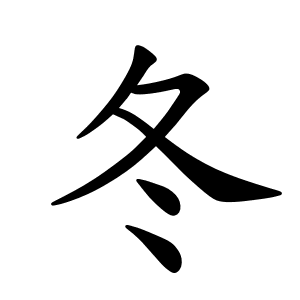冬
- winter;
- the end of the year;
Etymology
Oracle bone script (甲骨文 jiǎgǔwén): drawn as a bent line with circular shapes (like cherries) at each end, symbolizing something tied at both ends, meaning “to finish.”
Original sense: 冬 was the original character for 終 (end); “winter” was a later phonetic loan, since winter marks the conclusion of the yearly cycle.
Bronze inscriptions (金文 jinwen): some forms added 日 (sun) inside to emphasize temporal context.
Seal script (篆書 zhuànshū): 冫 (ice radical) was added to highlight coldness, producing the modern form.
Components: 夂 (go slowly, step) + 冫 (ice radical), though the original meaning has no connection with “feet.”
Usage in Korean
冬季 (동계) — winter season
冬眠 (동면) — hibernation
冬至 (동지) — winter solstice
立冬 (입동) — the start of winter (solar term)
冬服 (동복) — winter clothes
Words that derived from 冬
Additional notes
In early Shang oracle texts, only spring and autumn were clearly distinguished; “summer” (夏) and “winter” (冬) as seasonal terms developed later.
In Chinese, 冬 also serves as a simplified form of 鼕 (drum sound “dong”).
Calligraphic variants: in Chinese and Japanese fonts 冫 is written as two dots, but in some Korean fonts it appears as the full ice radical.
- 竹水卜 (HEY)
- ⿱ 夂 ⺀ (G T J V)
- ⿱ 夂 冫 (K)
